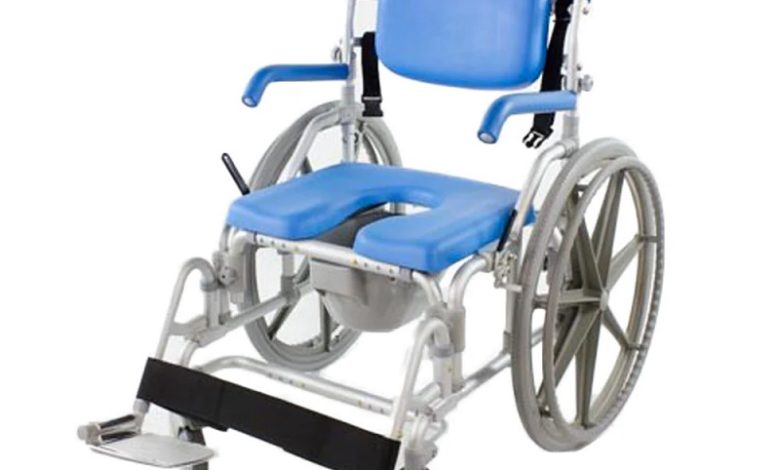Shower Freedom: Guide to Shower Wheelchairs

Table of Contents
Shower Freedom: Guide to Shower Wheelchairs
Showering with Independence: Unveiling the World of Shower Wheelchairs
For many people, showering can be a daily task filled with anxiety and difficulty. Limited mobility due to age, injury, or disability can challenge navigating a standard shower. This is where shower wheelchairs come in – life-changing mobility aids designed to empower individuals to regain independence and confidence during their shower routines.
What is a Shower Wheelchair?

Unlike a standard shower chair, a shower wheelchair is a rolling mobility device specifically designed for use in the shower. These wheelchairs typically feature:
- Durable, rust-resistant frames: Constructed from lightweight yet strong materials like aluminium or stainless steel, shower wheelchairs can withstand the constant moisture environment of a bathroom.
- Comfortable seating: Padded seats with backs provide support and prevent fatigue during showering.
- Wheels for manoeuvrability: Shower wheelchairs come with waterproof wheels that allow for easy movement within the shower stall.
- Commode opening (optional): Some shower wheelchairs have a built-in opening in the seat to accommodate a commode bucket, eliminating the need for separate transfers.
Benefits of Using a Shower Wheelchair:
Shower wheelchairs offer a multitude of benefits for individuals who require assistance in the shower:
- Increased Independence: Shower wheelchairs empower users to shower without relying on others for assistance, promoting self-care and dignity.
- Enhanced Safety: The stable platform and wheels of a shower wheelchair significantly reduce the risk of slips and falls in the slippery shower environment.
- Improved Comfort: Features like padded seats, backrests, and adjustable armrests provide a comfortable showering experience.
Things to Consider When Choosing a Shower Wheelchair:

Selecting the perfect shower wheelchair requires careful consideration of several factors:
- User Weight Capacity: To ensure safety and stability, choose a wheelchair with a weight capacity exceeding the user’s weight.
- Seat Width and Height: The seat width should be comfortable and allow easy transfers from a toilet or shower bench. Seat height should be adjustable to match the user’s needs.
- Features: Consider features like removable armrests for easier transfers, swing-away footrests for leg positioning, and reclining backs for added comfort.
- Bathroom Dimensions: Ensure the chosen shower wheelchair can manoeuvre comfortably within the shower stall’s doorway and overall space.
- Budget: Shower wheelchairs come in various price ranges. Consider the desired features, budget constraints, and insurance coverage options.
Additional Considerations for a Safe Showering Experience:
- Grab Bars and Shower Benches: Installing strategically placed grab bars and a shower bench in the shower stall can provide additional support and stability.
- Adjustable Showerhead: A showerhead mounted on a slide bar allows for height and direction adjustments, making the shower experience more comfortable and accessible.
- Non-Slip Mats: Equipping the shower floor with non-slip mats minimizes the risk of slipping and falling.
Where to Buy a Shower Wheelchair:
Shower wheelchairs can be purchased from various sources:
- Medical Supply Stores: Many medical supply stores carry a variety of shower wheelchairs and can assist you in choosing the right one for your needs.
- Online Retailers: Several online retailers specialize in mobility aids, offering a wide selection of shower wheelchairs at competitive prices.
- Occupational Therapists: Consulting an occupational therapist can be especially beneficial for personalized recommendations on shower wheelchairs and other bathroom safety equipment.
Shower Wheelchair: A Comprehensive Look at Different Types
Within the shower wheelchair category, there are various options to suit specific needs:
- Lightweight and Portable Shower Wheelchairs: These are ideal for individuals requiring occasional assistance or limited storage space. They are easy to manoeuvre and fold for compact storage.
- Heavy-Duty Shower Wheelchairs: Designed for users with higher-weight capacities, these wheelchairs offer increased stability and support.
- Bariatric Shower Wheelchairs: These cater to bariatric users, featuring wider seats and a higher weight capacity.
- Self-Propeling Shower Wheelchairs: These wheelchairs allow users to propel themselves independently using handrims, promoting a sense of autonomy.
- Attendant-Propelled Shower Wheelchairs: These wheelchairs are designed to be pushed by a caregiver.
Bathroom Transport Wheelchairs: Maneuvering with Ease
Bathroom transport wheelchairs, sometimes called sliding shower chairs or rolling shower chairs, are another type of mobility aid designed for navigating bathrooms.
These chairs typically share some characteristics with shower wheelchairs but have some key differences:
- Smaller footprint: Bathroom transport chairs are generally more compact than shower wheelchairs, making them ideal for smaller bathrooms.
- Lower profile: Shower wheelchairs often have a lower seat height than shower chairs, facilitating transfers from toilets or shower benches.
- May not have wheels: While some bathroom transport chairs have wheels for manoeuvrability within the bathroom, others focus solely on providing a stable platform for transfers.
Types of Bathroom Transport Wheelchairs:
There are various types of bathroom transport chairs available to cater to different needs:
- Shower Chair with Wheels: These chairs combine the functionality of a shower chair with the mobility of wheels. They are perfect for individuals who require assistance with showering and transferring within a bathroom.

- Shower Chair with Wheels for Elderly: These chairs often feature additional comfort features like padded seats, backs, and armrests, prioritizing safety and ease of use for seniors.
- Narrow Shower Chair with Wheels: Designed for smaller shower stalls or bathrooms with limited space, these chairs offer a narrower footprint while still providing a stable platform.
- Reclining Shower Chair with Wheels: These chairs offer the added benefit of a reclining backrest, which is ideal for individuals with limited mobility who require extra support during showering.
- Shower Chair with Wheels and Brakes: For enhanced safety, some shower chairs come equipped with brakes on the wheels to prevent accidental movement.
- Heavy Duty Shower Chair with Wheels: These chairs provide increased weight capacity and stability for heavier individuals.
- PVC Shower Chair with Wheels: PVC is lightweight and water-resistant, making these chairs a cost-effective option for some users.
Shower Wheelchair Ramps: Bridging the Gap
For individuals who have difficulty navigating a shower threshold with a shower wheelchair, a shower wheelchair ramp can be a valuable addition. These ramps create a smooth, gradual incline, allowing for easier access to the shower stall.
Shower Wheelchair Commode: A Multifunctional Solution

Some shower wheelchairs come with a built-in commode opening in the seat. This eliminates the need for separate transfers to the toilet and allows toileting to be addressed directly in the shower wheelchair.
Shower Wheelchair Dimensions: Ensuring a Perfect Fit
When choosing a shower wheelchair, it’s crucial to consider its dimensions to ensure it fits comfortably within your bathroom space. Here are some key measurements to consider:
- Overall Width: This ensures the wheelchair can manoeuvre through doorways and within the shower stall.
- Seat Width: This should be wide enough for the user to sit comfortably but narrow enough to allow transfers from a toilet or shower bench.
- Seat Height: The seat height should be adjustable to match the user’s needs and allow easy transfers.
- Overall Height: This ensures the wheelchair clears any low-hanging fixtures in the bathroom.
Shower Wheelchair Self Propelled vs. Attendant Propelled
The choice between a self-propelling and an attendant-propelling shower wheelchair depends on the user’s individual abilities.
- Shower Wheelchair Self-Propelled: These wheelchairs empower users with the ability to propel themselves using handrims, fostering independence during showering.
- Attendant-Propelled Shower Wheelchair: These wheelchairs are designed to be pushed by a caregiver, offering a stable platform for users who require more assistance.
Beyond the Wheelchair: Additional Shower Safety Considerations
While shower wheelchairs and transport chairs offer significant benefits, additional safety measures can enhance the showering experience:
- Grab Bars: Strategically placed grab bars provide secure handholds for getting in and out of the shower or transferring to a shower chair.
- Shower Bench: A shower bench offers a stable platform for sitting while showering, reducing fatigue and the risk of falls.
- Non-Slip Mats: Equipping the shower floor with non-slip mats minimizes the risk of slipping and falling.
Beyond the Standard: Exploring Specialized Shower Chairs
While the previous section covered various shower wheelchair and transport chair options, there are also specialized shower chairs designed for specific needs. One such option is the:
- Tilt-in-Space Shower Chair: This unique chair features a mechanism that allows the seat to tilt backwards while maintaining a level legrest position. This tilting motion can be beneficial for individuals with limited upper body strength or balance issues. The tilt helps to distribute weight more evenly and reduces the risk of shearing during showering.

Benefits of Tilt-in-Space Shower Chairs:
- Improved comfort and pressure relief for users with limited upper body strength.
- Enhanced safety by minimizing the risk of shearing during transfers or showering.
- Facilitates easier toileting for individuals who require assistance.
Who may benefit from a Tilt-in-Space Shower Chair?
This type of shower chair can be particularly helpful for individuals with:
- Spinal cord injuries
- Multiple sclerosis
- Arthritis
- Other conditions that limit upper body strength or balance
Things to Consider When Choosing a Tilt-in-Space Shower Chair:
- Weight capacity: Ensure the chair can accommodate the user’s weight.
- Tilt angle: Choose a chair with a tilt angle that meets the user’s needs.
- Transfer ease: Consider features like removable armrests or footrests to facilitate transfers.
- Comfort: Look for a chair with a padded seat and backrest for optimal comfort.
Shower Wheelchair Prices: Finding the Perfect Fit for Your Budget
Shower wheelchairs come in a variety of styles and functionalities, and the price reflects that! But fear not, there’s a perfect option to fit (quite literally) most budgets. Here’s a breakdown to help you navigate the pricing landscape:
- Budget-Friendly Freedom: Are you looking for a lightweight, portable shower chair? Great news! These start around $100, making them a fantastic option for occasional assistance.
- Standard Support: Standard shower wheelchairs offer increased stability and features like padded seats. Expect a range of $200 to $500, depending on the brand and bells and whistles.
- Heavy-Duty Champions: For users requiring a higher weight capacity and robust construction, heavy-duty shower wheelchairs range from $500 to $800 (and sometimes beyond). They’re the ultimate champions of bathroom independence.
- Bariatric Options: Designed for larger users, bariatric shower wheelchairs typically cost between $800 and $1200. They prioritize comfort and support for a safe and dignified showering experience.
Remember, these are just general ranges. The final price can vary depending on factors like:
- Features: Fancy extras like reclining backs or removable armrests can increase costs.
- Material: Stainless steel offers superior durability compared to chrome or plastic, and the price reflects that.
- Brand Name: Sometimes, brand reputation plays a role.
- Retailer: Prices can differ between online stores, medical supply shops, and physical therapy providers.
Here are some budget-smart tips:
- Compare prices: Don’t settle for the first option you see! Shop around and compare prices from different retailers.
- Insurance Coverage: Check with your insurance provider to see if they cover shower wheelchairs or bathroom safety equipment.
- Sales & Discounts: Retailers often have sales or discounts throughout the year. Keep an eye out for deals!
The most important factor – Remember, the most important factor is choosing a shower wheelchair that meets your needs and provides safety and comfort. Don’t hesitate to consult with a healthcare professional or occupational therapist for personalized recommendations based on your situation.
Frequently Asked Questions (FAQs) about Shower Wheelchairs
What is the difference between a shower chair and a shower wheelchair?
Shower chairs are typically stationary and designed for sitting while showering. Shower wheelchairs, on the other hand, have wheels for manoeuvrability within the shower stall and sometimes throughout the bathroom.
How much weight can a shower wheelchair hold?
The weight capacity of a shower wheelchair varies depending on the model. It’s crucial to choose a wheelchair with a weight capacity exceeding the user’s weight to ensure safety and stability.
Do I need a shower wheelchair ramp?
If you have difficulty navigating a shower threshold with your shower wheelchair, a shower wheelchair ramp can be a valuable addition. It creates a smooth incline for easier access to the shower stall.
Are there different types of shower wheelchairs?
Yes! There are various types of shower wheelchairs available, including:
- Lightweight and portable models
- Heavy-duty models for higher-weight capacities
- Bariatric shower wheelchairs for larger users
- Self-propelling models for independent manoeuvring
- Attendant-propelled models for caregiver assistance
Where can I buy a shower wheelchair?
You can purchase shower wheelchairs from various sources, including:
- Medical supply stores
- Online retailers specializing in mobility aids
- Occupational therapists who can provide personalized recommendations
How do I choose the right shower wheelchair?
Several factors come into play when choosing a shower wheelchair, such as:
- User weight capacity
- Seat width and height for comfort and transfers
- Desired features like removable armrests, reclining backs, and brakes
- Bathroom dimensions to ensure manoeuvrability
- Budget and insurance coverage options
Is a shower wheelchair waterproof?
Shower wheelchairs are designed for use in the shower and are typically constructed with water-resistant materials. However, it’s always a good practice to dry the wheelchair thoroughly after use to prevent rust or corrosion.
Can I use a shower wheelchair with a commode?
Some shower wheelchairs come with a built-in commode opening in the seat, eliminating the need for separate transfers to the toilet.
I am still unsure about which shower wheelchair is right for me. What should I do?
Consulting a healthcare professional like an occupational therapist can be very beneficial. They can assess your individual needs and recommend the most suitable shower wheelchair for you.
By providing this comprehensive guide and addressing frequently asked questions, you’ll be well-equipped to make informed decisions regarding shower wheelchairs and reclaim your independence in the shower routine.
Also, showering shouldn’t be a battle. With the right shower wheelchair, you can reclaim your independence and confidence in the bathroom. This guide has equipped you with the knowledge to make informed decisions and find the perfect solution for your needs.
Here are some additional resources that you might find helpful:
- [National Institute on Disability, Independent Living, and Rehabilitation Research (NIDILRR)](URL national institute for disability independent living and rehabilitation research ON nidilrr.nih.gov) – Provides information and resources on various disability and rehabilitation topics.
- [American Occupational Therapy Association (AOTA)](URL occupational therapy association ON American Occupational Therapy Association aota.org) – Offers resources on how occupational therapists can help with bathroom safety and mobility.
We hope this guide has been helpful! Do you have any questions or experiences with shower wheelchairs that you’d like to share? Leave a comment below – we’d love to hear from you!



